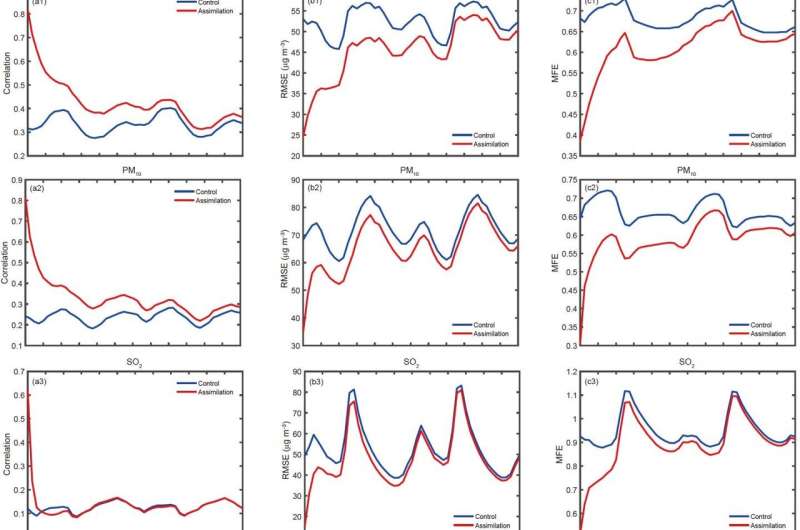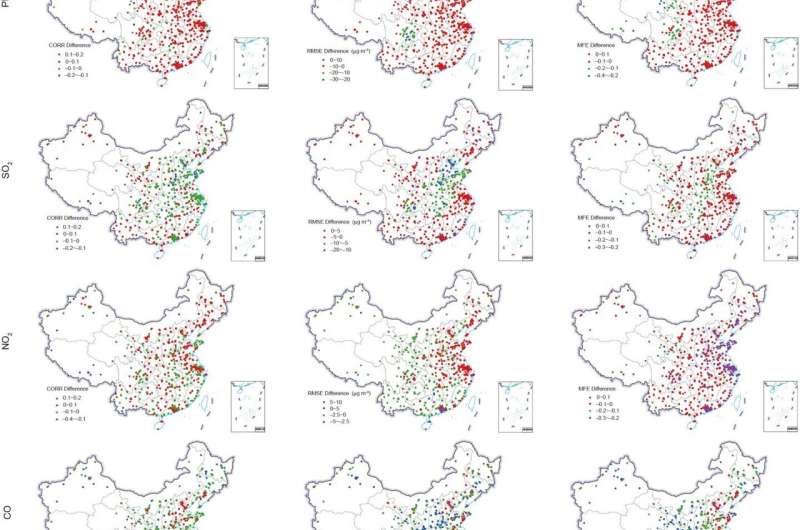Data assimilation significantly improves forecasts of aerosol and gaseous pollutants across China

Aerosols are important components of the atmosphere and have an adverse impact on atmospheric visibility and human health, which also affect the climate via direct radiative forcing and the interaction with clouds and precipitation. In recent years, regional aerosol pollution incidents have occurred frequently in China, so enhancing early warning capability for air pollution is of great significance and has always been a concern of researchers.
As an indispensable tool, air quality numerical models have been widely employed in air quality analysis and prediction and to forecast spatial-temporal evolutions of atmospheric pollutants. Data assimilation (DA) technology can organically combine observation information and model background fields to develop a theoretically optimal analysis field, so as to improve the prediction accuracy by optimizing the model initial field. At present, the bulk of assimilation studies of pollutants, however, focused on the separated assimilation of gaseous pollutants or particulate matter PM2.5 and PM10 total mass, few researchers considered the chemical mechanism of aerosol multi-components in multi-particle size sections.
Recently, Master Wang Daichun, Dr. You Wei (corresponding author) and Associate Professor Zang Zengliang from the Institute of Meteorology and Oceanography, National University of Defense Technology, China used the three-dimensional variational assimilation algorithm to establish a chemical DA system, which included aerosol components such as elementary carbon, organic carbon, sulfate, nitrate, chloride, sodium salt, ammonium salt, inorganic and particle PM2.5, PM10 in addition to gaseous pollutants such as SO2, NO2, CO, O3 mass concentrations as control variables. Subsequently, simultaneous assimilation of hourly mass concentration observations of PM2.5, PM10, SO2, NO2, CO, and O3 released by the China National Environmental Monitoring Centre was performed to evaluate this system. The results show that this assimilation system significantly improves analyses and forecasts of both particulate matter and gaseous pollutant mass concentrations. The study was published in Science China Earth Sciences under the title "A three-dimensional variational data assimilation system for a size-resolved aerosol model: Implementation and application for particulate matter and gaseous pollutant forecasts across China."

The study revealed variable benefits from assimilation on different pollutants. DA significantly improves PM2.5, PM10, and CO forecasts leading to positive effects that last more than 48 h. The positive effects of DA on SO2 and O3 forecasts last up to 8 h but that remains relatively poor for NO2 forecasts. After analysis, the positive effect of DA on pollutant forecasts has a certain relationship with the life cycle of pollutants. In the case of pollutants with a long lifespan, a longer forecast range due to DA can be expected than for pollutants with short life spans, such as NO2 and O3.
The study also showed that the influence of assimilation varies in different areas. It is possible that the positive effects of DA on PM2.5 and PM10 forecasts can last more than 48 h across most regions of China. Indeed, DA significantly improves SO2 forecasts within 48 h over north China, and much longer CO assimilation benefits (48 h) are found in most regions apart from north and east China and across the Sichuan Basin. Data show that DA is able to improve O3 forecasts within 48 h across China with the exception of southwest and northwest regions and the O3 DA benefits in southern China are more evident, while from a spatial distribution perspective, NO2 DA benefits remain relatively poor.
The results enrich the study of aerosol and gaseous pollutants. It not only has the reference value for the monitoring, prediction, and control of air pollutants, but also has the important scientific significance to deal with the pollution weather, the management, and prediction of atmospheric environment in China.
More information: Daichun Wang et al, A three-dimensional variational data assimilation system for a size-resolved aerosol model: Implementation and application for particulate matter and gaseous pollutant forecasts across China, Science China Earth Sciences (2020). DOI: 10.1007/s11430-019-9601-4
Journal information: Science China Earth Sciences
Provided by Science China Press





















